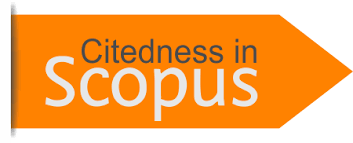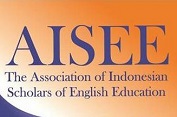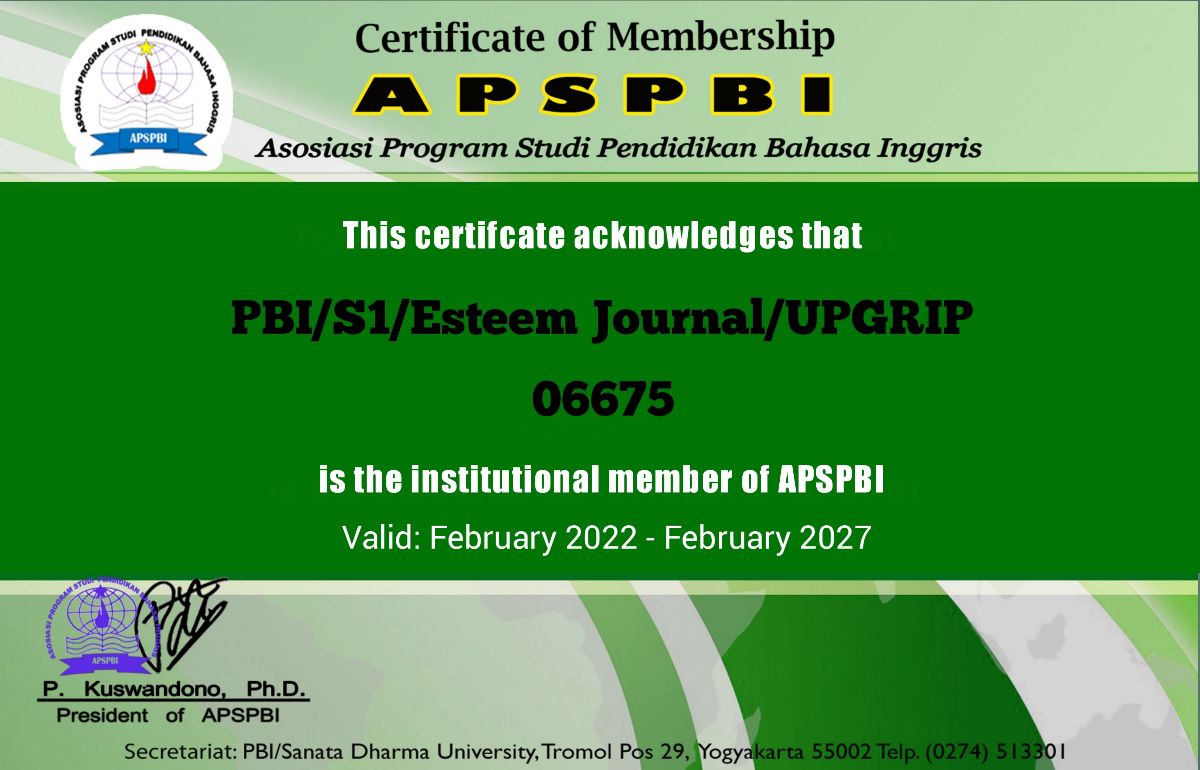E-LEARNING AND LEARNING INTEREST TOWARDS THE STUDENTS’ ENGLISH ACHIEVEMENT
DOI:
https://doi.org/10.31851/esteem.v4i1.5135Keywords:
E-Learning, Achievement, InterestsAbstract
This research aimed to determine that E-Learning Based Learning and students’ interest in learning can make a significant difference in increasing learning achievement. Researchers took two research samples. The first group was taught using E-Learning and the second using conventgional (face-to-face). To collect data, both groups were given a speech test and an interest in learning questionnaire. For E-Learning, data had collected using the Zoom application which is evaluated by the researcher using a questionnaire consisting of 2 parts, namely fluency and understanding. Meanwhile, students' interest in learning was evaluated using a questionnaire. In E-Learning, lecturers and students consider several topics given by the lecturer. After that, they decide what type of product they produced on their project as a final result, such as: Visual Learning Media, Audio Learning Media and Audiovisual Learning Media. The results showed that (1) there was a significant difference in both student interest in learning (t = 8.822, p <.000) and achievement (t = 7.911, p <.000) from the experimental group after being taught using E-Learning, (2 ) the contribution to the improvement of student learning achievement was 98.7% and interest in learning was 92.1%. So it can be concluded that E-Learning-based learning has an effect on student achievement and interest in learning.
References
Arikunto, S. (1993). Prosedur penelitian: Suatu pendekatan praktek. Yogyakarta: CV Pustaka Utama Yogyakarta.
Basrowi & Soeyono (2007). Metode analysis data sosial. Kediri: CV Jenggala Pustaka Utama.
Beh, Y. (1997). Current research in Southeast Asia. RELC Journal. 28(1), 175-179.
Bloom, B. S (2003). Language assessment: Principles and classroom practices. New York, NY: Pearson Education.
Brown, H. D. (1994). Teaching by principles: An interactive approach to language
pedagogy. Englewood Cliffs, NJ: Prentice Hall Regents.
Brown, H. D. (2000). Principles of language learning and teaching. New York, NY: Pearson Education.
Campbell, D. T., & Stanley, C. (1963). Experimental and quasi-experimental designs for Campbell, D. T., & Julian, C. S. (1991). The experimental and quasi experimental designs for research on teaching. The English Teacher, 3(1), 34-37.
Chaney, A. L. (2005) Educational research: planning, conducting, and evaluating quantitative and qualitative research. Boston, MA: Pearson Education.
Celce, M. (2001). Teaching English as a second or foreign language. Orlando, FL: Earl Mcpeek.
Dawson, C. ( 2007). A practical guide to research method. Oxford: Oxford University Press.
Dornyei, Z. (2001). Motivational strategies in the classroom. Cambridge: Cambridge University Press.
Ducket, B. (2009). Longman dictionary of contemporary. Edinbugh: Pearson Education Limited.
Harmer, J. (.2007). The practice of English language teaching. Cambridge, UK:: Cambridge University Press.
Hughes, A. (1989). Testing for language teachers. Cambridge: Cambridge University Press
.
Hulsman, A. (2002). Theory of interest. The quarterly journal of Austrianeconomic, 18(2), 161-175.
Jaya, A. (2017). Sentence Patterns of Narrative Text in English Textbook in Indonesia. English Community Journal. 1 (2).
Jaya, A. (2017). The Influence of the Teachers’ Questioning Strategies on the Eleventh Grade Students’ Speaking Achievement at SMKN 1 Palembang. JELT Jambi-English Language Teaching. 2(1).
Lee, C., Chao, L., & Chen. (2011). The influence of interest in learning and learning hours on learning outcomes of vocational college students in Taiwan; using a teacher’s’ instructional attitude as the moderator. Global Journal of Engineering Education, 2(2), 16-20.
McMillan, J.H., & Schumacher, S. (2010). Research in education: evidence-based inquiry, 2(2). New York, NY: Pearson.
Muhammad Nasirulloh. (2007). Manfaat E-learning Untuk Pendidikan. Makalahditerbitkan. Diakses darihttp://media.diknas.go.id.Tanggal 16 April 2013.
Onno W. Purbo. (2002). Teknologi E-learning Berbasis PHP dan MySQL.
Richards, C. J., & Rodgers, T.S. (2001). Approaches and methods in language teaching. Cambridge: Cambridge University press.
Rusman,Deni Kurniawan,dan Cepi Riyana. (2011). Pembelajaran BerbasisTeknologi Informasi dan Komunikasi. Mengembangkan profesionalitas guru. Jakarta : PT. Raja Grafindo Persada.
Setiawati, Mariana. Nurfaraditha, Iin. dkk. Perbandingan Metode Pembelajaran E-learning Dan Tradisional.(Program Studi Sistem Infomrasi, Fakultas Ilmu Komputer, Universitas Gunadarma).Unpublished. Depok
Siegle, D. (2009). The importance of recognizing student’s interest and parenting for high potential. New York, NY: Addition Wesley Longman.
Skehan, P. (1998). A cognitive approach to language learning. Oxford: Oxford University Press.
Soekartawi. 2007. Merancang dan menyelenggarakan E-learning. Yogyakarta: Ardana Media.
Sumarmi, Made Ayu. 2010. Pengaruh E-Learning Dan Minat Belajar Terhadap Kemampuan Membaca Bahasa Inggris ( Studi Eksperimen pada SMK Negeri 3 Tabanan).Unpublished. Tabanan.
Downloads
Published
Issue
Section
License
Copyright Notice
Authors who publish with this journal agree to the following terms:
In order to assure the highest standards for published articles, a peer review policy is applied. In pursue of the compliance with academic standards, all parties involved in the publishing process (the authors, the editors and the editorial board and the reviewers) agree to meet the responsibilities stated below in accordance to the Journal publication ethics and malpractice statement.
Duties of Authors:
- The author(s) warrant that the submitted article is an original work, which has not been previously published, and that they have obtained an agreement from any co-author(s) prior to the manuscript’s submission;
- The author(s) should not submit articles describing essentially the same research to more than one journal;
- The authors(s) make certain that the manuscript meets the terms of the Manuscript Submission Guideline regarding appropriate academic citation and that no copyright infringement occurs;
- The authors(s) should inform the editors about any conflict of interests and report any errors they subsequently, discover in their manuscript.
Duties of Editors and the Editorial Board:
- The editors, together with the editorial board, are responsible for deciding upon the publication or rejection of the submitted manuscripts based only on their originality, significance, and relevance to the domains of the journal;
- The editors evaluate the manuscripts compliance with academic criteria, the domains of the journal and the guidelines;
- The editors must at all times respect the confidentiality of any information pertaining to the submitted manuscripts;
- The editors assign the review of each manuscript to two reviewers chosen according to their domains of expertise. The editors must take into account any conflict of interest reported by the authors and the reviewers.
- The editors must ensure that the comments and recommendations of the reviewers are sent to the author(s) in due time and that the manuscripts are returned to the editors, who take the final decision to publish them or not.
Authors are permitted and encouraged to post online a pre-publication manuscript (but not the Publisher final formatted PDF version of the Work) in institutional repositories or on their Websites prior to and during the submission process, as it can lead to productive exchanges, as well as earlier and greater citation of published work (see The Effect of Open Access). Any such posting made before acceptance and publication of the Work shall be updated upon publication to include a reference to the Publisher-assigned DOI (Digital Object Identifier) and a link to the online abstract for the final published Work in the Journal.





























